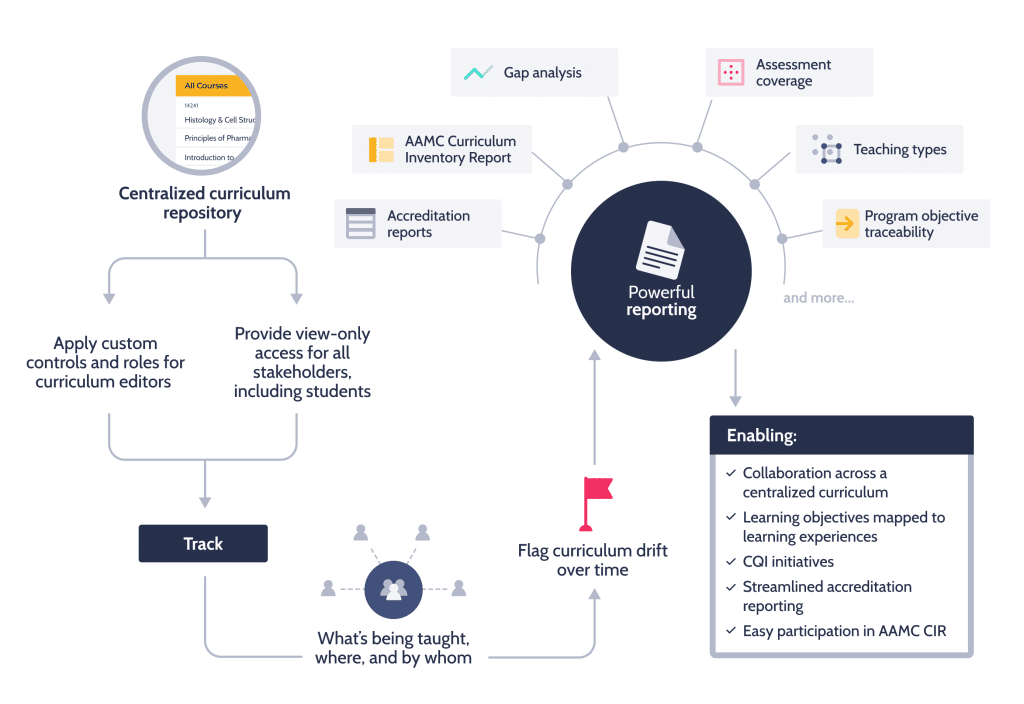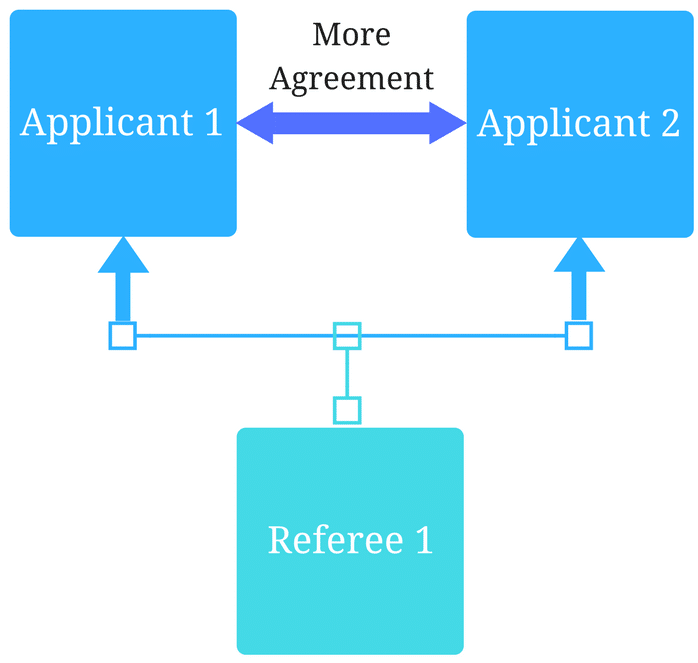A guide to curriculum management for schools of osteopathic medicine

September 15, 2020
In July 2020, the American Association of Colleges of Osteopathic Medicine (AACOM) announced a partnership with the AAMC that would grant AACOM members access to the AAMC Curriculum Inventory (CI). Previously, AAMC was only able to collect Osteo school data using the Annual Osteopathic Medical School Questionnaire.
As Osteo schools prepare to participate in the AAMC curriculum reporting process, they may be wondering where to begin. We prepared this guide to help deans of osteopathic schools better understand the curriculum inventory reporting process and get started in advance of 2021.
What are CI reports and why do you need them?
The AAMC Curriculum Inventory (CI) is designed as a benchmarking and reporting tool. It includes the content, structure, delivery, and assessment of U.S. and Canadian medical school curricula.
The process of creating a curriculum inventory is often also referred to as curriculum mapping. Some items often contained within a curriculum map include:
- content, learning objectives, and keywords at the program, course, and event levels
- learning event details, including timing, frequency, instructional approach, and resources
- content assessed, including assessment methods
- curricular structure, e.g., number of academic levels, hours of instruction, and special tracks or programs
Value of the AAMC Curriculum Inventory
The curriculum inventory allows participants to learn what other schools are doing and help them make informed decisions about any necessary changes they identify as necessary. In addition to the usual science and clinical subjects, a curriculum can include behavioral and socioeconomic subjects.
These subjects often address current “hot topic” issues or trends that schools can share ideas about how to address and create programming for them.
Internally, curriculum reports can facilitate continuous quality improvement, discussion among curriculum committees and teaching faculty, and support schools’ accreditation monitoring. They can also be used to enhance medical education research and inform legislators and the general public of curricula.
Why a curriculum inventory reporting tool?
Accreditors expect proof and rigor around standards, meaning schools must track and report on more information in more detail and at more frequent intervals than before. You need the right tools to adjust your curriculum on a more frequent basis.
Curriculum mapping and reporting also facilitate a process of continuous improvement. Only by recording and reporting on curriculum activities can frequent changes be made in the interest of improvement.
Accreditors also appreciate when schools submit standardized, comparable data. A curriculum mapping tool allows you to use existing AAMC reporting lists and connect your data to the CI. It will also flag any existing errors that may have transpired, as well as allow you to make any necessary changes.
Getting started with curriculum management
Over the next 12 months, the AAMC CI team will be including a special feature in the CI newsletter highlighting tips and tasks, taking a month-by-month approach that Osteo schools may wish to follow along with.
AAMC also has a list of approved curriculum mapping vendors, including Acuity, that can assist your school with adopting a curriculum management process. Read below to learn more about selecting a curriculum mapping vendor.
Sharing curriculum data with key stakeholders
A curriculum map allows you to share learning objectives, course schedules, assessments and learning materials with all of your stakeholders: students, residents, faculty, and administrative staff.
Each of these user groups requires different information or have different levels of permissions around what they are allowed to access. A curriculum reporting tool allows schools to set permissions for these groups and enable the different “views” they need.
Improving the organization of your curriculum
If there are any redundancies or gaps in your curriculum, mapping software will help you identify them by tracking objectives, content, and learning activities for every course.
A properly maintained curriculum map allows you to demonstrate your program comprehensively, both for your internal curriculum committees and for accreditation purposes.
Saving time with curriculum reporting
With curriculum management software, you can replace the tedious, manual process of entering curriculum data. Faculty and administrative staff can spend far too much time on manual additions and edits.
With mapping software, you enter curriculum information once and save the duplicated effort of entering it several times into several systems in order to perform assessments or submit reports.
Combine curriculum scheduling with the reporting process
Traditional curriculum mapping tools, including some of the vendors on the AAMC vendors list, will only allow for adjustments or additions at infrequent intervals. A full-featured curriculum management software solution allows you to integrate your curriculum management with the tools used by staff and students daily, e.g., curriculum scheduling.
Incorporating these operations into your curriculum mapping system will keep everything up to date and save a lot of time preparing reports for accreditation.
Choosing a curriculum inventory reporting tool
In order to participate in the AAMC CI, schools can choose to use their own institutionally developed curriculum and learning management system or engage one of the AAMC CI participating vendors, which includes us here at Acuity.
As a recognized AAMC vendor with approved data safety measures in place, Osteo schools can trust that our curriculum inventory reporting tools will allow them to onboard according to the AAMC requirements.
As with any software purchase, schools are advised to conduct independent research before selecting a vendor. Why choose Acuity? We have the industry’s largest market share, with over 40 percent of MedEd institutions in the US and Canada. We also offer a more robust suite of tools, including a powerful Analytics offering that will empower schools with a data warehouse and dashboard to generate time-saving visual reports that expedite the accreditation and learner assessment processes.

Learn more about CI for Osteo schools
To learn more about how your osteopathic school of medicine can make the transition to a comprehensive curriculum management process, book a demo of Acuity.
Related Articles

How interviews could be misleading your admissions...
Most schools consider the interview an important portion of their admissions process, hence a considerable…
Reference letters in academic admissions: useful o...
Because of the lack of innovation, there are often few opportunities to examine current legacy…
